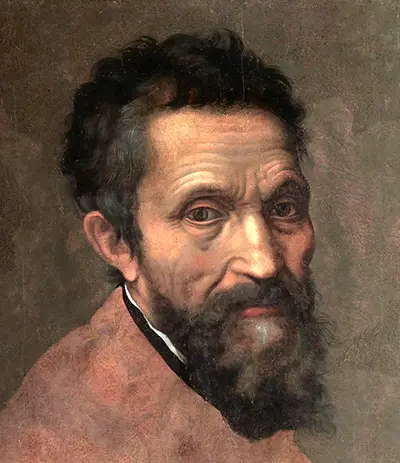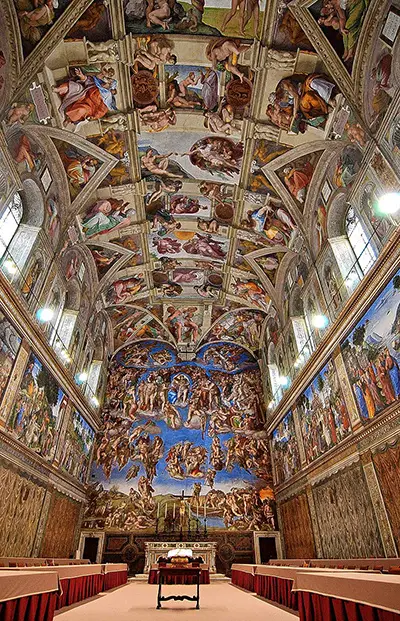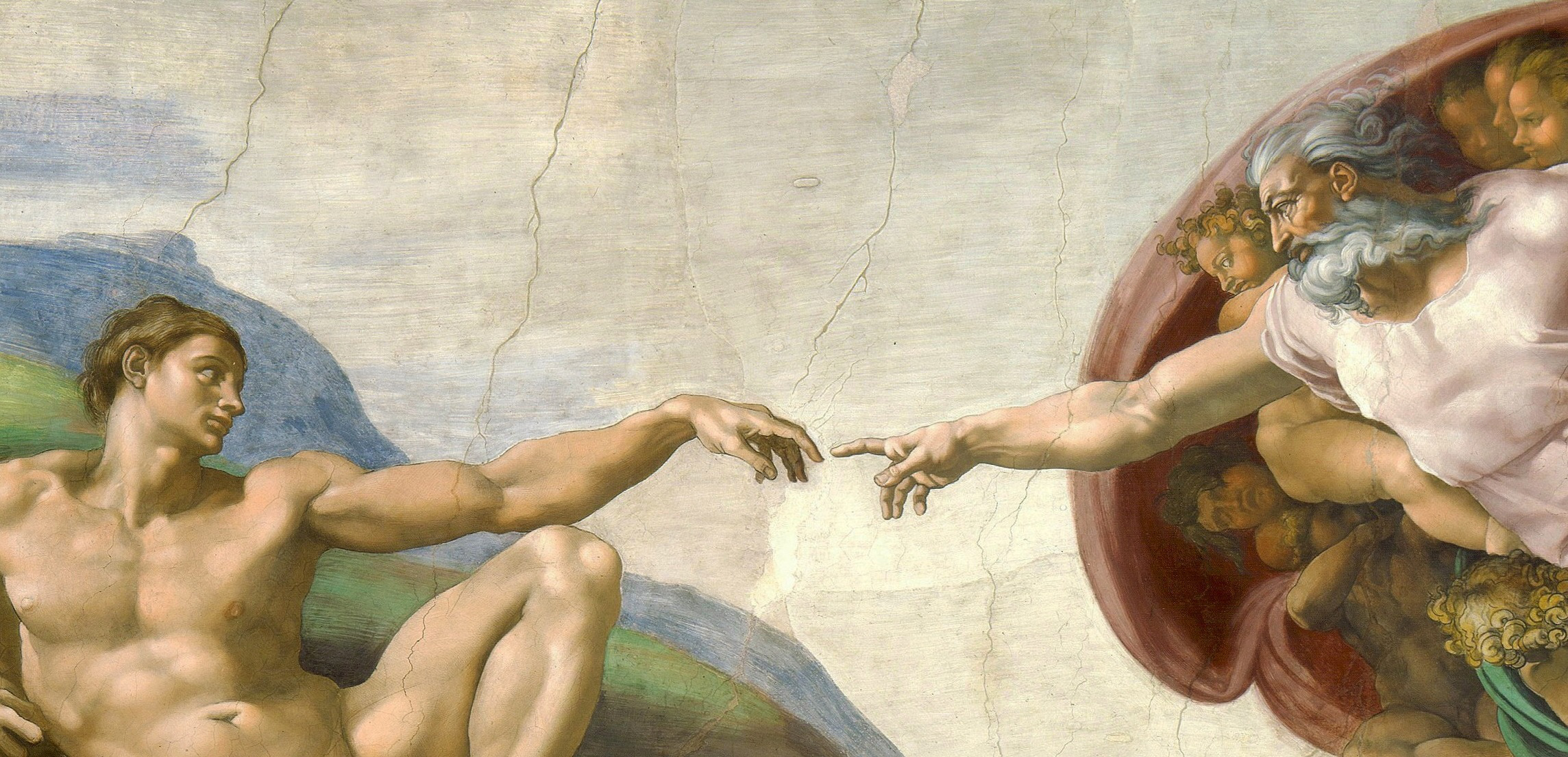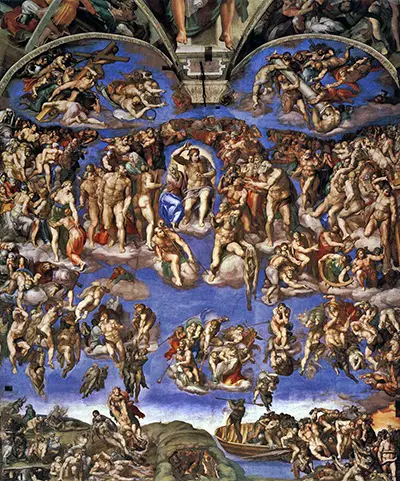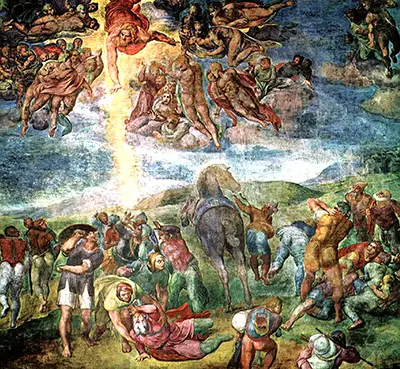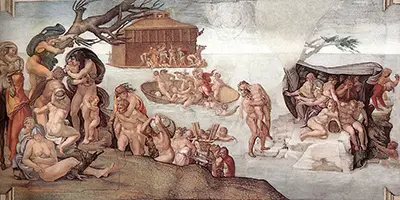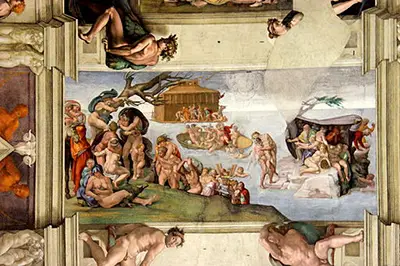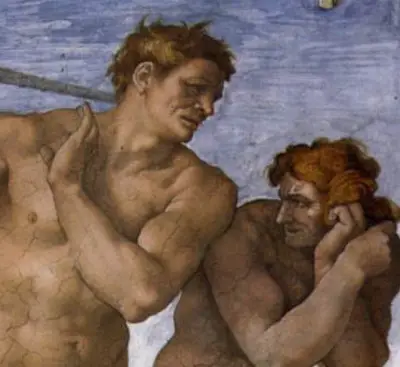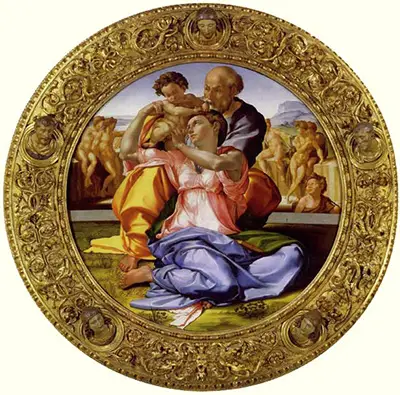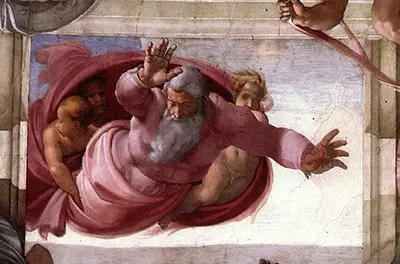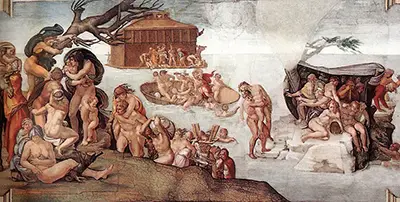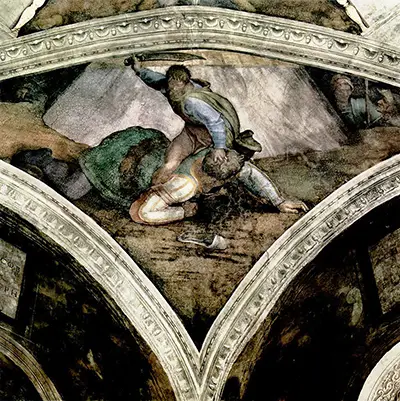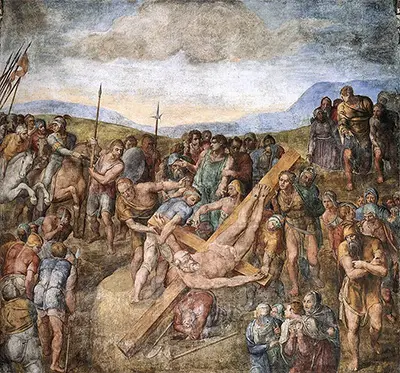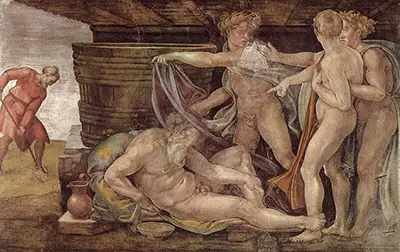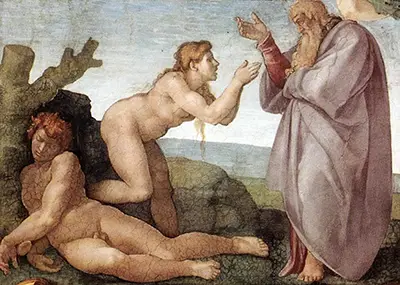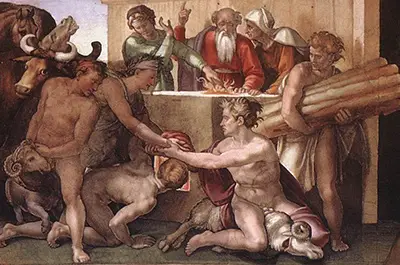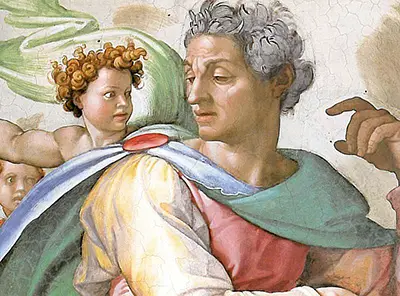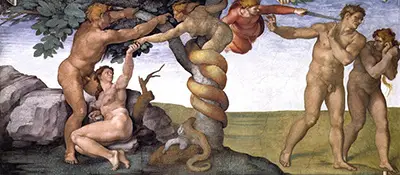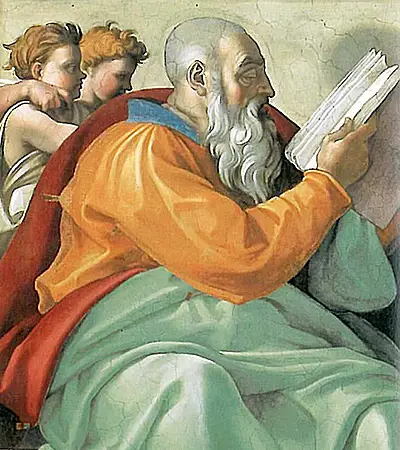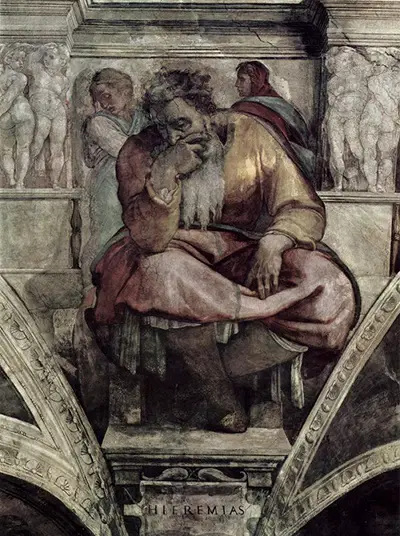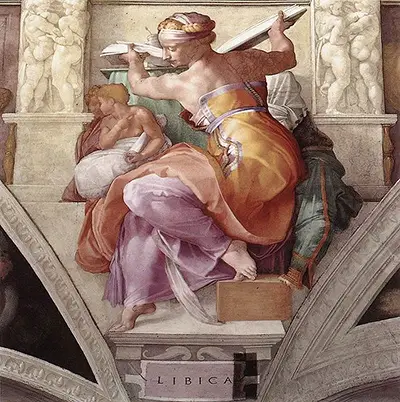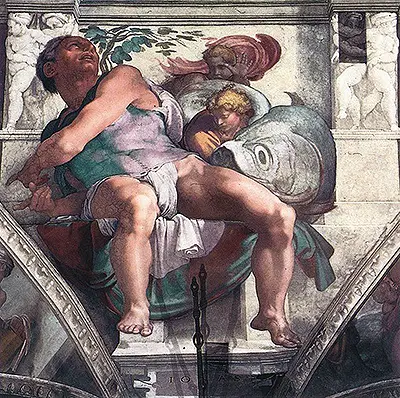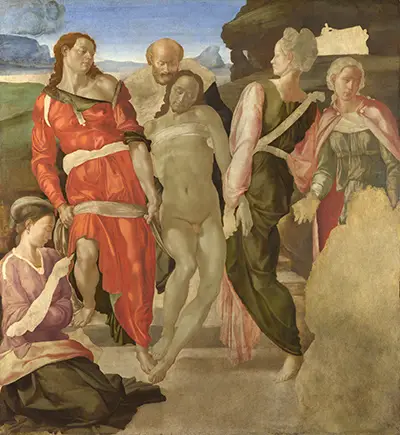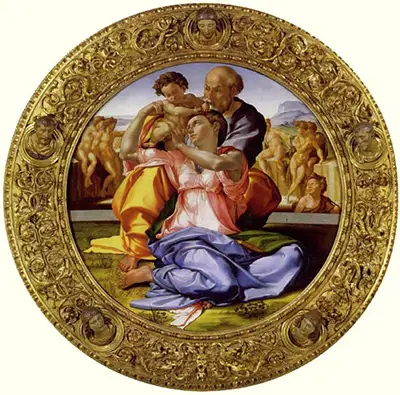His figures were in proportion and life like in contrast to the style of medieval Christian art and included an immense amount of detail. The artist was well known for his interest in human anatomy, developed through working with human corpses early in his career. This marked a revolution in European art.
The best known painting by Michelangelo is undoubtedly the fresco known as The Creation of Adam, depicting the legend of the creation of mankind from the book of Genesis. Adam is pictured in a reclining posture with the deity leaning towards him, an iconic artwork that speaks to spectators through the ages. It is believed that Michelangelo took inspiration for this work from one of Ghiberti’s panels depicting Adam and Eve.
Michelangelo was a devout Catholic but he was also strongly influenced by themes from ancient Greek and Rome, as well as contemporary scientific ideas which feature in his paintings. For example the shape of the red cloak in The Creation of Adam mirrors that of the human brain, suggesting that Adam himself is endowed with special knowledge.
Another fresco, The Last Judgement, depicts the second coming of Christ and took Michelangelo seven years to finish. This massive painting was unveiled in 1541 on the altar wall of the Sistine Chapel.
However some spectators objected to the pictures of naked bodies on display in a religious setting and subsequently it was decided to cover up the genitals, a task completed by one of Michelangelo’s apprentices. Other less well known paintings can be viewed in the Pauline Chapel of the Vatican, including frescoes such as The Conversion of Saul and The Crucifixion of St Peter.
Michelangelo’s methods influenced the Florentine artists who followed him. The 16th century saw a flowering of artistic endeavour under the patronage of the wealthy duke of Florence, Cosimo de Medici. A new artistic movement known as the Bella Maniera or Mannerism developed, a style that followed the Renaissance and preceded the Baroque, predominantly influenced by the colour palettes and forms created by Michelangelo.
According to Vasari, Mannerist artists produced paintings of “idealized grace”, with the use of vibrant colours and complex composition. Michelangelo influenced later artists such as Pontormo, Bronzino and Raphael. Spectators were drawn to paintings with idealized, muscular figures and exaggerated poses reminiscent of Greek and Roman sculptors.
Michelangelo was an example of a true Renaissance man, achieving prominence in several fields of artistic and intellectual endeavour and considered a genius by his contemporaries. He was the first artist to receive recognition during his own lifetime and his influence on the development of western art cannot be overestimated.
Born in 1475 in Caprese, Tuscany, Michelangelo was known as a Renaissance sculptor and architect, as well as a painter. Early influences on Michelangelo include Renaissance artists such as Lorenzo Ghiberti, Donatello and Giovanni.
At age 15 Michelangelo began to study under Giovanni at the school founded by Lorenzo di Medici where he created the marble reliefs Madonna of the Stairs and Battle of the Centaurs. He would have studied masters such as Donatello and Giotto as well as Greek and Roman sculpture belonging to the Medici collections in Florence.
Amongst his best known works was the ceiling of the Sistine chapel in the Vatican city, an immensely ambitious task which included painting more than 400 lifesize figures from the Bible, which the artist completed in 1508.
The work was carried out using fresco painting which involved the artist lying on his back on scaffolding. Following this Michelangelo was popularly known as "il divino" or the divine one.
Michelangelo produced impressive frescos alongside the sculptures for which he remains best known for.
Michelangelo's series of frescos in the Sistine Chapel marked him out as a confident artist who was willing to take on huge commissioned projects. The detail involved in several of his paintings is quite extraordinary, and we outline some of the most famous Michelangelo paintings in this section.
Portraits of religious icons were common place during the Renaissance and served as an excellent way for artists like Michelangelo to show off their impressive anatomical knowledge and technical drawing skills.
Most of those rich enough at this time to entice the best artists with large commissions were involved in the religious areas of Italian society, such as the Pope who took in Michelangelo for work on the Sistine Chapel. For this reason, it was inevitable that much of the resulting work was based on religious themes.
The photograph here is of The Last Judgement, and you can read more about that fresco further down this page, as well as being able to enjoy a more detailed image of it too.
Creation of Adam Painting
The centerpiece and our personal highlight within the Sistine Chapel is The Creation of Adam, which you can see pictured here.
The striking symbolism has been re-created in modern media in thousands of different ways and captures the period of the Renaissance beautifully.
It is recommended to take the time to really study this fresco in great detail, with several high resolutions images of the original currently doing the rounds. Standing from afar will not really give you a proper understanding of the beauty to be found here and digital art can serve a great purpose in this regard.
This particular painting is popular with art fans and it is instantly recognisable for even the most occasional of followers of Michelangelo and the Renaissance. It remains the most reproduced piece of artwork from Michelangelo's career for major international art retailer, Art.com.
This artwork remains a critical piece from the artist's life and we have granted it it's own specific page to reflect that. Despite being theoretically just an element of a larger piece, it is correctly considered a masterpiece in it's own right.
The Last Judgement Painting
Powerful iconic scenes continued in the Renaissance as Michelangelo contributed The Last Judgement, which appears on the altar wall in the Sistine Chapel.
It still seems incredible that one building could have been gifted so many masterpieces, though credit must be given in the selection of Michelangelo to produce much of the work.
You may see that we have also chosen The Last Judgement painting to be our main homepage banner, though later on at some point there will be several photographs which rotate one after another.
Many of the artist's sculptures are in proportions which would be difficult for our homepage, with the main image being more of a landscape shape than portrait.
The closeup photograph to the right captures the main focus of the fresco and underlines the incredible detail to be found within this inspiring artwork.
The Last Judgement was a commissioned piece which came around many years after the artist's original work in the Sistine Chapel, and underlines how his earlier work was held in such high regard.
Fall of Mankind and Expulsion from Paradise Painting
This key religious term relates to the removal of man after disobedience towards God.
There are examples of the fall of mankind in many different religions and cultures, with many artists related to them also featuring this powerful topic in their work.
Michelangelo chose to depict a scene from the Fall of Mankind and Expulsion from Paradise within his series of frescos which remain on the ceiling of the Sistine Chapel.
The scene was another stunning element to the work of Michelangelo in the chapel, but the artwork also serves as a timely reminder to religious followers as to the potential pitfalls that result from losing one's way.
Conversion of Saul Painting
The Conversion of Paul the Apostle is an event in the life of Paul the Apostle, or Saul as he is sometimes referred to.
The conversion painting by Michelangelo came around later on in his career and struggled to get quite the same academic respect as some of his earlier works. The moderately more mannerist approach used by the artist in this piece is perhaps the reason for that.
The Cappella Paolina in the Vatican Palace, Vatican City houses this artwork which has now become much more appreciated by art fans and academics than it was when first completed.
The Crucifixion of St Peter followed on straight after this fresco, and it is believed that Michelangelo took several years to complete the Conversion of Saul.
The Flood and Noah's Ark Painting
This fresco captures the deluge which symbolises the sanctuary of the church in the form of Noah's Ark.
Michelangelo chose to focus this fresco on the human emotions that surrounded this momentous moment, with little coverage of the actual natural disaster that was occuring.
The painting depicts many people being lost to the flood due to their attachment to objects and items, whilst those willing to give up such things are able to gain access to the Ark, and save themselves as a result.
The Flood plus Noah's Ark have been captured by all manner of artists, across different movements, who look to take advantage of the hard-hitting nature of this scene and the familiarity that so many people have with this episode.
Holy Family with St John Painting
This circular painting was produced on a panel by artist Michelangelo in 1506.
This artwork is just over a metre in diameter and is one of the few panel artworks from the Renaissance to still be in reasonable condition. It is currently on display in the Galleria degli Uffizi, Florence, Italy.
Florence continues to be seen by most as the original home of the Italian Renaissance, but it is in Vatican City where most of Michelangelo's most famous paintings can be located.
The Holy Family with St John painting is available as a framed print from the links shown to the right. It offers characteristics which are slightly unusual for this artist, such as it's circular nature and the use of panelling.
Creation of the Sun and Moon Painting
The full title of this fresco was The Creation of the Sun, Moon and Planets.
Michelangelo is believed to have completed this artwork in 1511, as part of his much larger commission to cover the ceiling of the Sistine Chapel. This was just one of a number of highly critical Christian-based scenes that the artist depicted together in a stunning series of work.
The painting shows God creating the plant world, which we all continue to enjoy today, as well as the planetary system on which so much of our lives rely.
God's facial expressions in this piece aim to outline the efforts that he was forced to go to in order to continue his creation of plants, people and plants.
Prophet Isaiah Painting
Prophet Isaiah is one of seven Old Testament prophets to have been completed by Michelangelo.
Italian painter Caravaggio, famous for his dark and powerful style, is believed to have been heavily influenced by the work of Michelangelo and, in particular, this particular painting.
This topic has appeared in the work of several notable Renaissance artists, but it is Michelangelo's version which is considered to be the best. Critics appreciate it's bright colours and also the accuracy of the anatomy of the prophet.
This fresco remains one of the better understood and respected elements of the Sistine Chapel ceiling series.
Erithrean Sibyl Painting
This fresco is also sometimes termed The Erythraean Sibyl instead, depending on whether you use the artist's spelling.
1509 marked the completion of this fresco, and it is yet another significant contribution to the overall series that sits across the ceiling of the Sistine Chapel.
There still appears to be some confusion over the precise messages being communicated by Michelangelo through this artwork, with the Erythraea having a relatively vague pose and with an equally unclear facial expression.
This fresco may not command the interest of other elements in the series, but is still an artwork that is worthy of note for it's artistic and technical qualities.
Creation of Eve with Four Ignudi Painting
The Creation of Eve is captured in the centre of this fresco, with the igundis surrounding it.
Much discussion has surrounded the precise meaning of various elements of this painting, with no-one really sure as to exactly which historic scene is being captured by Michelangelo within this piece.
The Destruction of the Tribe of Ahab, Followers of Baal and the Death of Nicanor have all been mentioned as possible sources of inspiration for the artist here, but a clear conclusion has yet to be drawn.
Adam and Eve are two of the most important icons incorporated by Michelangelo into his series of paintings, as they are fundamental to the teachings of Christianity and the relationship between God and humanity.
The Fall of Man Painting
The Fall of Man teaches us to respect God and to not be distracted by other influences.
This idea is somewhat similar to the story behind Noah's Ark, which ultimately represents the problems experienced by those who placed too much importance on their own possessions.
Many of the scenes captured by Michelangelo came from the book of Genesis and aimed at encouraging followers to continue along the right course in their life, from the perspective of God and Christ.
The overall tone to some of these religious paintings can be dark and depressing but the scenes themselves could hold inspiring imagery which would always attract your attention.
